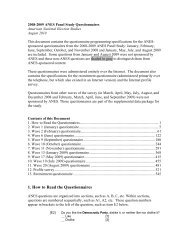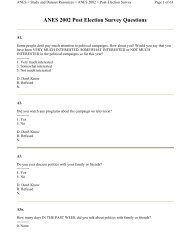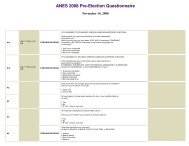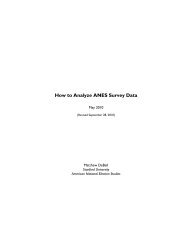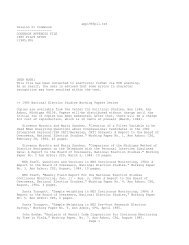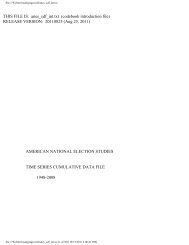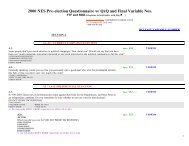Methodology Report and User's Guide - American National Election ...
Methodology Report and User's Guide - American National Election ...
Methodology Report and User's Guide - American National Election ...
You also want an ePaper? Increase the reach of your titles
YUMPU automatically turns print PDFs into web optimized ePapers that Google loves.
the question the first time, but if they clicked “Next” a second time, they were allowed to<br />
continue the survey without answering the question. This equivalent to a refusal to<br />
answer the question.<br />
“-8 Don’t know” is a code assigned to telephone recruitment if the respondent answered<br />
the question by saying they did not know how to answer.<br />
“-9 Refused” is a code assigned to telephone recruitment if the respondent refused to<br />
answer a question.<br />
In addition to the st<strong>and</strong>ard missing data codes descried above, a few variables use other<br />
values for missing data, <strong>and</strong> some alphanumeric (string) variables use “.” or the “system<br />
missing” value instead of a number. On some state variables that use two-letter state<br />
abbreviations, “X” denotes missing state data.<br />
Restricted-use data<br />
As with other ANES studies, most variables from the Panel Study are included in the<br />
public-use data file that is available to the public for free. Access to some variables is<br />
restricted to protect respondents’ privacy. Data that could identify a respondent as part of<br />
a small <strong>and</strong> recognizable population or that could identify a respondent as a resident of a<br />
small geographic area have been redacted from the public-use data file. Such variables<br />
include the respondent’s city <strong>and</strong> county of residence, date of birth, <strong>and</strong> detailed<br />
racial/ethnic identity when the respondent is a member of a small minority group. Such<br />
variables are labeled “RESTRICTED ACCESS” on the data file, <strong>and</strong> the data are coded -<br />
3. When respondents typed a response to an open-ended question <strong>and</strong> their response<br />
included information that could pose a risk, the potentially problematic response was<br />
redacted <strong>and</strong> marked as “[REDACTED].” For details concerning redaction, see DeBell,<br />
Krosnick, <strong>and</strong> Lupia (2010).<br />
Data analysts interested in obtaining access to restricted access variables may do so by<br />
following the special access request procedures described on our website at<br />
http://www.electionstudies.org/rda/anes_rda.htm.<br />
Item time data<br />
For many questions, the elapsed time the respondent took to answer was recorded. Times<br />
recorded are the elapsed time in seconds between the question appearing on the screen<br />
<strong>and</strong> the time that the “Next” button was clicked to advance to the next screen.<br />
If the respondent clicked “Next” without answering <strong>and</strong> received the item nonresponse<br />
prompt (asking the respondent to please answer the question), then the recorded time<br />
reflects the time that “Next” was clicked a second time to actually move on to the next<br />
question.<br />
20



